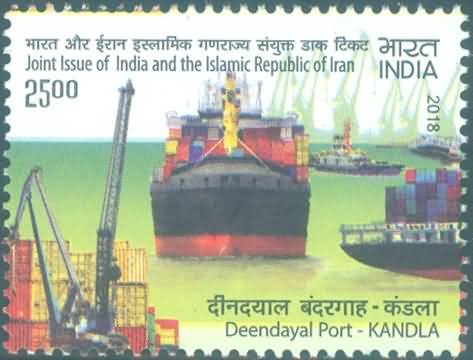Deendayal Port, Kandla, India

Technical Data
| Stamp Set | India Iran Joint Issue |
|---|---|
| Date of Issue | February 17, 2018 |
| Denomination | Rs. 25 |
| Quantity | 501,000 |
| Perforation | 13¾ x 13¾ |
| Printer | Security Printing Press, Hyderabad |
| Printing Process | Wet Offset |
| Watermark | No Watermark |
| Colors | Multicolor |
| Credit (Designed By) | Shri Kamleshwar Singh Smt. Alka Sharma |
| Catalog Codes |
Michel IN 3360A Stamp Number IN 3009 Yvert et Tellier IN 3050 Stanley Gibbons IN 3475 |
| Themes | Container Ships | Joint Issues | Ports | Trade |
Deendayal Port – Gateway to India’s Maritime Growth
Deendayal Port, formerly known as Kandla Port, is one of India’s most important and busiest ports, located in the Kutch District of Gujarat on the Gulf of Kutch. This natural deep seaport plays a crucial role in India’s maritime trade and is a symbol of the nation’s economic strength and connectivity with global markets.
Historical Background
The origins of Deendayal Port trace back to 1931, when Maharao Khengarji initiated the construction of an RCC Jetty, marking the beginning of its journey. After the partition of India in 1947, Kandla became the chief seaport serving western India, as Karachi Port was then in Pakistan. Since then, Deendayal Port has evolved into a major trade hub, handling vast volumes of cargo and contributing significantly to India’s economy.
Growth and Achievements
Deendayal Port has consistently ranked among India’s top-performing ports. In 2007–08, it was recognized as the No. 1 port in the country, a position it has retained for several years. On March 31, 2016, the port made history by handling 100 million tons of cargo in a single year, becoming the first major port in India to achieve this milestone on a single-port basis.
Strategic Significance
Situated approximately 256 nautical miles southeast of Karachi and 430 nautical miles north-northwest of Mumbai, Deendayal Port’s location makes it a key maritime gateway for India’s trade with the Middle East, Africa, and Europe. It serves as a vital link in India’s international trade network and plays an important role in the nation’s logistics and shipping sectors.
Economic Importance
The port handles a wide range of cargo, including petroleum, chemicals, fertilizers, food grains, and containers. Its advanced infrastructure, deep-water capacity, and efficient cargo handling systems make it a preferred choice for domestic and international traders alike.
Symbol of India–Iran Connectivity
In the India–Iran Joint Commemorative Stamp Issue, Deendayal Port was featured alongside Shahid Beheshti Port, Chabahar, symbolizing trade and commerce connectivity between the two nations. The design represents the shared vision of strengthening regional maritime cooperation and enhancing economic ties.
Conclusion
Today, Deendayal Port stands as a testament to India’s maritime legacy and its forward-looking trade infrastructure. From its humble beginnings in 1931 to becoming a world-class port, it continues to anchor India’s aspirations for economic growth, regional connectivity, and global trade leadership.
